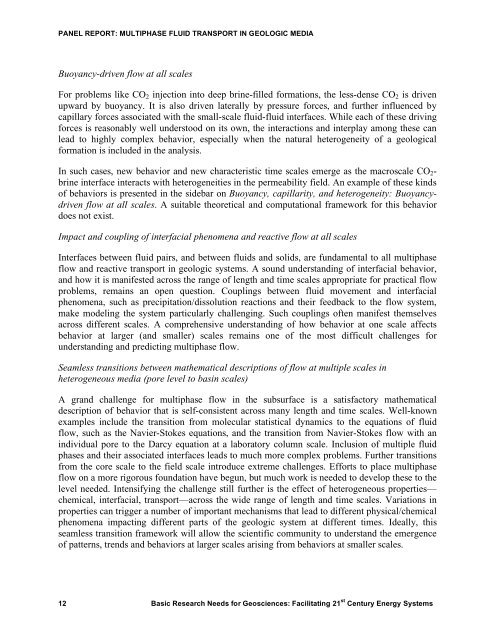Basic Research Needs for Geosciences - Energetics Meetings and ...
Basic Research Needs for Geosciences - Energetics Meetings and ...
Basic Research Needs for Geosciences - Energetics Meetings and ...
- No tags were found...
You also want an ePaper? Increase the reach of your titles
YUMPU automatically turns print PDFs into web optimized ePapers that Google loves.
PANEL REPORT: MULTIPHASE FLUID TRANSPORT IN GEOLOGIC MEDIABuoyancy-driven flow at all scalesFor problems like CO 2 injection into deep brine-filled <strong>for</strong>mations, the less-dense CO 2 is drivenupward by buoyancy. It is also driven laterally by pressure <strong>for</strong>ces, <strong>and</strong> further influenced bycapillary <strong>for</strong>ces associated with the small-scale fluid-fluid interfaces. While each of these driving<strong>for</strong>ces is reasonably well understood on its own, the interactions <strong>and</strong> interplay among these canlead to highly complex behavior, especially when the natural heterogeneity of a geological<strong>for</strong>mation is included in the analysis.In such cases, new behavior <strong>and</strong> new characteristic time scales emerge as the macroscale CO 2 -brine interface interacts with heterogeneities in the permeability field. An example of these kindsof behaviors is presented in the sidebar on Buoyancy, capillarity, <strong>and</strong> heterogeneity: Buoyancydrivenflow at all scales. A suitable theoretical <strong>and</strong> computational framework <strong>for</strong> this behaviordoes not exist.Impact <strong>and</strong> coupling of interfacial phenomena <strong>and</strong> reactive flow at all scalesInterfaces between fluid pairs, <strong>and</strong> between fluids <strong>and</strong> solids, are fundamental to all multiphaseflow <strong>and</strong> reactive transport in geologic systems. A sound underst<strong>and</strong>ing of interfacial behavior,<strong>and</strong> how it is manifested across the range of length <strong>and</strong> time scales appropriate <strong>for</strong> practical flowproblems, remains an open question. Couplings between fluid movement <strong>and</strong> interfacialphenomena, such as precipitation/dissolution reactions <strong>and</strong> their feedback to the flow system,make modeling the system particularly challenging. Such couplings often manifest themselvesacross different scales. A comprehensive underst<strong>and</strong>ing of how behavior at one scale affectsbehavior at larger (<strong>and</strong> smaller) scales remains one of the most difficult challenges <strong>for</strong>underst<strong>and</strong>ing <strong>and</strong> predicting multiphase flow.Seamless transitions between mathematical descriptions of flow at multiple scales inheterogeneous media (pore level to basin scales)A gr<strong>and</strong> challenge <strong>for</strong> multiphase flow in the subsurface is a satisfactory mathematicaldescription of behavior that is self-consistent across many length <strong>and</strong> time scales. Well-knownexamples include the transition from molecular statistical dynamics to the equations of fluidflow, such as the Navier-Stokes equations, <strong>and</strong> the transition from Navier-Stokes flow with anindividual pore to the Darcy equation at a laboratory column scale. Inclusion of multiple fluidphases <strong>and</strong> their associated interfaces leads to much more complex problems. Further transitionsfrom the core scale to the field scale introduce extreme challenges. Ef<strong>for</strong>ts to place multiphaseflow on a more rigorous foundation have begun, but much work is needed to develop these to thelevel needed. Intensifying the challenge still further is the effect of heterogeneous properties—chemical, interfacial, transport—across the wide range of length <strong>and</strong> time scales. Variations inproperties can trigger a number of important mechanisms that lead to different physical/chemicalphenomena impacting different parts of the geologic system at different times. Ideally, thisseamless transition framework will allow the scientific community to underst<strong>and</strong> the emergenceof patterns, trends <strong>and</strong> behaviors at larger scales arising from behaviors at smaller scales.12 <strong>Basic</strong> <strong>Research</strong> <strong>Needs</strong> <strong>for</strong> <strong>Geosciences</strong>: Facilitating 21 st Century Energy Systems
















